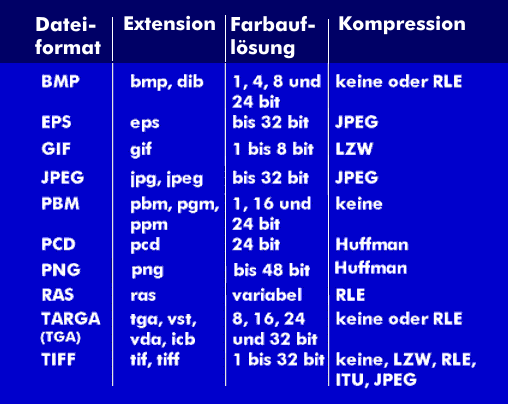graphic format (GR)
Graphics are divided into vector graphics and pixel graphics. Vector graphics are based on graphic elements such as lines, rectangles, circles and polygons, which are stored and displayed starting from coordinate points in their mathematical description. Typical file formats for vector graphics are Corel Draw files (*.cdr), Encapsulated Postscript (*.eps) or Drawing Interchange Format (*.dxf).
Data range of the different graphic file formats
Pixel graphics are represented in raster form, with each pixel representing a digital value. Since the data volume of such a raster graphic increases proportionally with the vertical and horizontal resolution as well as the color depth, such graphics may well be in the two- digit MB range. Assuming a resolution of 2,048 x 1,536 for QXGA and a color depth of 24 bits, or 3 bytes, the amount of data is 9.5 MB. For this reason, most pixel formats have a compression algorithm to reduce the amount of data.
The different pixel formats differ in resolution and color depth. For example, some are limited to a color depth of 8 bits such as the Graphics Interchange Format( GIF), which corresponds to 256 different colors, while others are limited to 16 bits, 24 bits such as bitmap graphics, or 32 bits such as the EPS file format, JPEG and TGA files, or 48 bits such as Tagged Image File Format ( TIFF), Photoshop( PSD) or Portable Network Graphics( PNG). Some of the mentioned graphic formats are used in application programs, others are also suitable for the web. Flashpix( FPX), Deja Vu( DJVU) and Shockwave Flash( SWF) should also be mentioned here.
Data content of graphic files
Graphics files contain graphic data types such as polygons, rasterizationdata, texts, and the attributes for each data type such as the stroke width, color, font, font size, etc. The tasks of graphic file formats include the transfer of graphic information between graphic application programs and output devices such as monitors, printers or plotters. In addition, graphics file formats must be archived in a product-specific and product-neutral manner.
Graphics file formats also differ in terms of the color model implemented. Pixel graphics generally use the RGB color model, whereas vector graphics are often based on the CMYK color model.


